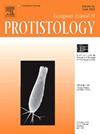O short-branch Microsporidia, where art thou? Identifying diversity hotspots for future sampling
IF 1.6
2区 生物学
Q4 MICROBIOLOGY
引用次数: 0
Abstract
Short-branch Microsporidia were previously shown to form a basal grade within the expanded Microsporidia clade and to branch near the classical, long-branch Microsporidia. Although they share simpler versions of some morphological characteristics, they do not show accelerated evolutionary rates, making them ideal candidates to study the evolutionary trajectories that have led to long-branch microsporidian unique characteristics. However, most sequences assigned to the short-branch Microsporidia are undescribed, novel environmental lineages for which the identification requires knowledge of where they can be found. To direct future isolation, we used the EukBank database of the global UniEuk initiative that contains the majority of the publicly available environmental V4 SSU rRNA gene sequences of protists. The curated OTU table and corresponding metadata were used to evaluate the occurrence of short-branch Microsporidia across freshwater, hypersaline, marine benthic, marine pelagic, and terrestrial environments. Presence–absence analyses infer that short-branch Microsporidia are most abundant in freshwater and terrestrial environments, and alpha- and beta-diversity measures indicate that focusing our sampling effort on these two environments would cover a large part of their overall diversity. These results can be used to coordinate future isolation and sampling campaigns to better understand the enigmatic evolution of microsporidians’ unique characteristics.
短枝微孢子虫啊,你在哪里?为未来采样确定多样性热点
以前的研究表明,短支微孢子虫在扩展的微孢子虫支系中形成一个基级,并在经典的长支微孢子虫附近分支。虽然它们具有某些形态特征的简单版本,但它们并没有显示出加速的进化速度,因此是研究导致长支微孢子虫独特特征的进化轨迹的理想候选者。然而,分配给短支小孢子虫的大多数序列都是未被描述的、新的环境品系,对它们的鉴定需要了解它们在哪里可以找到。为了指导未来的分离工作,我们使用了全球 UniEuk 计划的 EukBank 数据库,该数据库包含了大多数公开的环境 V4 SSU rRNA 基因序列。我们利用编辑的 OTU 表和相应的元数据来评估淡水、高盐、海洋底栖、海洋水层和陆地环境中短支小孢子虫的出现情况。存在-不存在分析推断,短支小孢子虫在淡水和陆地环境中最为丰富,α-和β-多样性测量结果表明,将取样工作集中在这两种环境中将涵盖其整体多样性的大部分。这些结果可用于协调未来的分离和取样活动,以更好地了解微孢子虫独特特征的神秘演变。
本文章由计算机程序翻译,如有差异,请以英文原文为准。
求助全文
约1分钟内获得全文
求助全文
来源期刊

European journal of protistology
生物-微生物学
CiteScore
4.60
自引率
20.70%
发文量
55
审稿时长
14.6 weeks
期刊介绍:
Articles deal with protists, unicellular organisms encountered free-living in various habitats or as parasites or used in basic research or applications. The European Journal of Protistology covers topics such as the structure and systematics of protists, their development, ecology, molecular biology and physiology. Beside publishing original articles the journal offers a forum for announcing scientific meetings. Reviews of recently published books are included as well. With its diversity of topics, the European Journal of Protistology is an essential source of information for every active protistologist and for biologists of various fields.
 求助内容:
求助内容: 应助结果提醒方式:
应助结果提醒方式:


